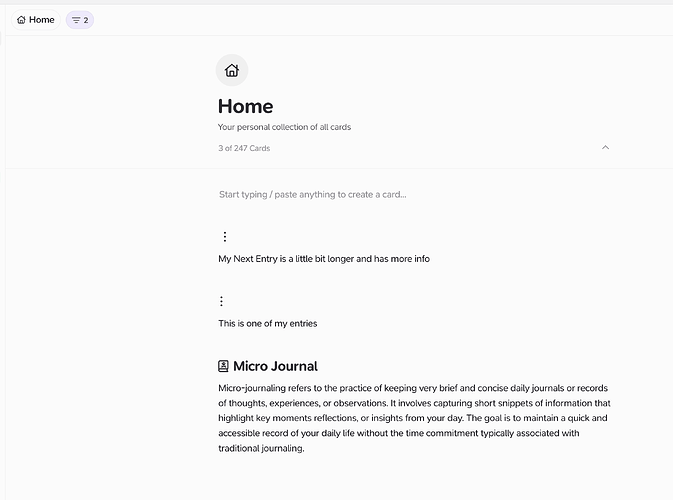Beyond purposes of “Micro-journalling” there’s a particular very powerful note-taking paradigm already “out there” that I think the Supernotes team could benefit from studying…
The app I consider to be the closest competitor to Supernotes in terms of philosophy and features is Mem.ai.
(I would probably be using it, if it weren’t for an extremely slow mobile app.)
Going further than Supernotes, their unit of focus is called a “mem” and it can be any snippet of text whatsoever.
For quick entry of thoughts, you’re encouraged to simply text the Mem app (through your main Text Message app).
At any point upon review, you can search by date, and you’ll see all those micro-journaled thoughts right there on the page, as if it was a daily journal. From there you can mass-tag or individually tag them for use in other filtered views.
The same applies for any type of note-taking you’re doing. You casually submit “mems” (thoughts) throughout the day, and at any time you can filter by tags or words-you-used to collect them on one page.
The difference being: While in Supernotes the unit container of information is a “Card” (which requires a title), in Mem.ai the unit container is in a sense the written thought itself. Which means that when you filter Mems by tags, dates, or text… you get – rather than a list of cards – a page full of the thoughts themselves, in one narrative flow.
In terms of elegance in really “going all the way” with this paradigm of flattening the hierarchy of information so that you can quickly filter for whatever you like from any direction…
Mem.ai definitely outdoes Supernotes.
But while the desktop version is genuinely an amazing experience in terms of power and flexibility… Unfortunately, the mobile version – at least last I checked – is strangely slow as to be unusable for my purposes.
That said, I do enjoy the “Cards” paradigm of Supernotes.
What I would wonder – maybe as a challenge to the Supernotes team – is if there could be a way to place even more emphasis on “The Thought Itself” rather than “The Card”?
What users are expressing in this thread is that “The ‘Cards’ are in the way of what we’re trying to accomplish.”
And yet, the driving philosophies of both Mem.ai and Supernotes is essentially the same.
So I wonder if there might be a simple way for Supernotes to incorporate Mem.ai-style note-taking?
Could it be as simple as a toggle for each card – or perhaps even globally thru preferences – to use cards “sans title” ?
(Maybe a user could, say, set all Light Blue cards to be in “Naked” mode.)
I think a so-called “Naked Mode” would make Supernotes essentially as capable as Mem.ai in terms of interacting with the “The Thoughts Themselves”…
… At least partly… in illusion, enough for certain users who would benefit from the powerful ability to, say, see a page of every individual thought you tagged #bookproject1 or in which you used the words “great idea”, presented all on one page in a single narrative – Rather than a bunch of cards that need to be clicked on.
Where I don’t see a simple toggle option matching what Mem.ai can do is that because they use individual thoughts as their basic container, it’s possible within any document to tag a single line to turn it into a searchable/filterable “mem”.
For example, you could go through your writing and tag great lines with “#quoting_myself” and then by clicking on the tag, you’ll instantly get a single page of your best lines.
That’s pretty revolutionary, I think. And I personally can’t foresee Supernotes accomplishing that without a fundamental recoding. But if you’re up to the challenge, I’d be excited to see the result!
But in the meantime, I think a good “Feature Request” that would help the causes of not just “Micro-Journaling” but overall making the user experience a bit more Seamless… By selectively eliminating the unnecessary “Card Interface” and showing the “Thoughts Themselves”… Would be to have a way to use cards in “Naked Mode”.
- To present this feature request in a way that perfectly fits the “Cards” paradigm…
“Naked Mode” would be like using Index Cards as most students do in the writing phase of writing a research paper, organizing them in front of you with the written info visible.
(vs. What Supernotes currently allows, which is like looking at your card spread seeing only “Section 1: First Paragraph”, “Conclusion” etc.)
So essentially the feature request – (feel free Mods to cross-post this to Feature Requests, if appropriate) – is simply to have a mode where we can “Preferentially View The BACK of The Card” 

